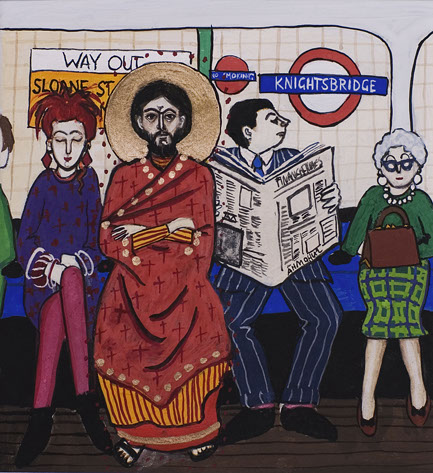+ Earlier "ransom" theories of the atonement had suggested that Jesus paid Satan for the sins of the world; in so doing, Jesus took on himself the punishment that humanity deserved and became an eternal sacrifice.
+ Anselm rejected this notion for he believed that the Cross was somehow related to God becoming flesh; by entering the world as a human being, Christ made certain that all flesh could once again be renewed with divinity as it was in the beginning. In Anselm's world, the Cross is one of the consequences of the Incarnation.
 Therefore, the unblemished divinity of Jesus was offered to God in the flesh to make an everlasting restitution for the sins of the world. A pure and holy God, it was believed, would not tolerate sin - it had to be destroyed - so the only resolution to sin required death. In a fully Trinitarian understanding of the Sacred, God chose to let God's self make payment for sin through love. In a word, God in Christ bought back intimacy and life from God the Father by ransoming his life; through the Spirit, we may forever benefit from this restitution.
Therefore, the unblemished divinity of Jesus was offered to God in the flesh to make an everlasting restitution for the sins of the world. A pure and holy God, it was believed, would not tolerate sin - it had to be destroyed - so the only resolution to sin required death. In a fully Trinitarian understanding of the Sacred, God chose to let God's self make payment for sin through love. In a word, God in Christ bought back intimacy and life from God the Father by ransoming his life; through the Spirit, we may forever benefit from this restitution.Three inter-related thoughts challenge contemporary people who critically reflect on Anselm's theology:
+ First, it is steeped in medieval notions of justice. Our experience of justice is rarely satisfied with a substitute paying the price for an offense, but this was normative in Anselm's day. Wealthy land-owners could purchase another human being to pay-off their sentence with the understanding that justice was satisfied. That such an arrangement could be called justice in the 21st century is beyond comprehension.
+ Second, why is it that God requires the death of sinners? If God is all holy and all loving, in addition to all powerful, why is the eradication of sin by death the only just alternative? Further, if this is the way the Lord works, who needs Satan? As contemporary feminists have rightly argued, this sounds more like divine child abuse than justice and mercy? To be sure, justice is costly - no cheap grace, to be sure - but death? This limitation upon God's grace is staggeringly narrow and punitive.
+ And third, without great care and nuance, this way of understanding God's loving response to sin on the Cross also becomes brittle and grotesquely mechanical. As it too often the case in theology, Anselm's poetic hope becomes yet another formula for paying off a debt owed to the Lord - or the church. Anselm's intention, however, was much more tender as these words from Makoto Fujimura - a brilliant artist and writer in the Reformed tradition - make clear. Inspired by the poet Blake, he writes:
So I journeyed with Albion to the end of Blake's epic poem, where, at the foot of Christ on the Cross of Calvary, with his arms outstretched to reflect Christ's, Albion heard Jesus say, "Wouldest thou love one who never died
For thee, or ever die for one who had not died for thee?
And if God dieth not for Man and giveth not himself
Eternally for Man, Man could not exist; for Man is Love
As God is Love; every kindness to another is a little Death
In the Divine Image, nor can Man exist but by Brotherhood.
(Jerusalem, chapter 4, plate 96: 23-29)
These words caught me off guard. An eighteenth century Romantic poet and artist captured with eloquence and clarity, exactly the same message the twentieth century missionaries proclaimed in my church. Christ is the bridge, a gift, spanning the chasm created by our prideful hearts. We can only love if we are shown love; we can only die for another if another has died for us. To love is to die. And Christ's death on the cross demands the definition of love to be nothing less that this. This connection, an agreement of profound significance that spanned the centuries, penetrated my heart. In order to love my wife, I had to be willing to die. But even more, I had been dying for all the wrong reasons. I knew ART had been my treasure, the center of my life and my identity. I though ART to be my bridge to others and God. But this bridge, if not given the right perspective, could result in a distorted view of ourselves and God. (River Grace, pp. 8-9)
Like many other contemporary people, the limits of Anselm's theology do not speak to my experience with either justice or grace. At the same time, the heart of his poetic intent - especially as interpreted by Mako - is deeply persuasive to me. So let me be clear: to say that Anselm's worldview was shaped by the practices of medieval European justice does not denigrate his contribution to sacred thought - his commitment to the cause of Christ was too great - but rather highlights a key limitation of this theology. He was seeking to explain how God's incarnation brings us reunion with the sacred essence - and this continues to resonate - even while his notion of the Cross remains incomplete.






No comments:
Post a Comment